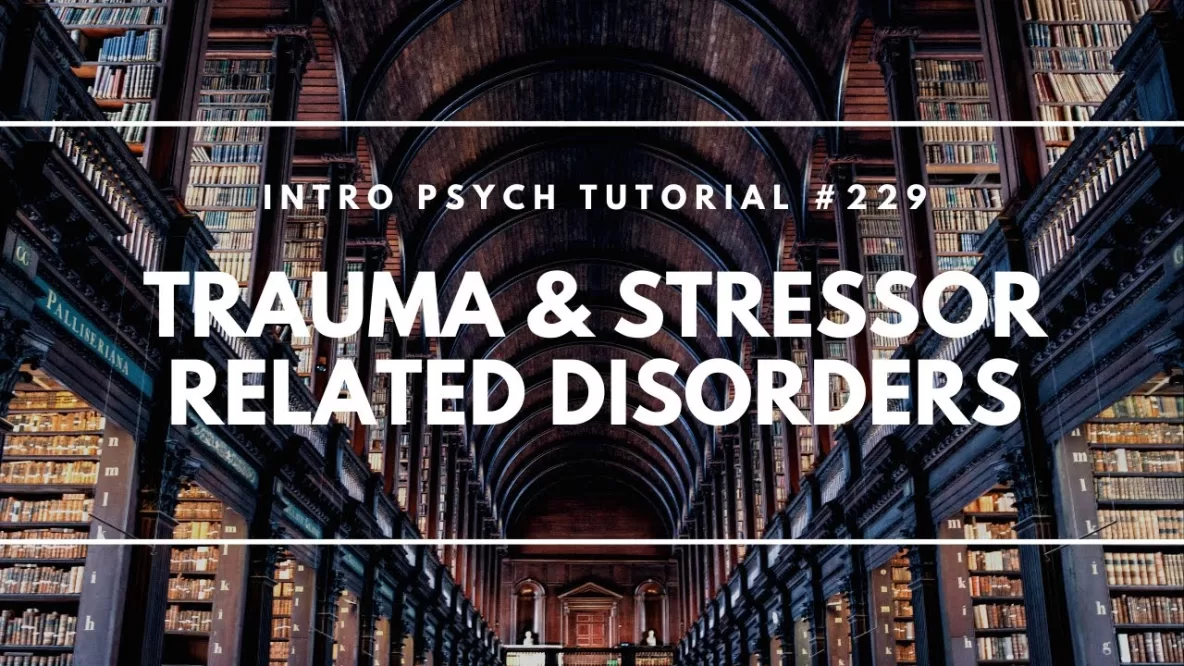In this video I describe some symptoms and the prevalence of several disorders in the Trauma and Stressor Related Disorders category of the DSM-5. These include Post-Traumatic Stress Disorder, Acute Stress Disorder, and Adjustment Disorder. Please note that the symptoms described in this video are not comprehensive and there are other symptoms involved in diagnosis for each of these disorders.
Previous video on PTSD (more detailed) here.
Video Transcript
Hi, I’m Michael Corayer and this is Psych Exam Review. In this video we’re going to look at the category of trauma and stressor related disorders in the DSM-5. And we’ll start by looking at PTSD or post-traumatic stress disorder and this is a disorder that I’ve talked about in a previous video, so I’ll post a link to that video in the description. Now one of the main symptoms that we see in PTSD is recurrent involuntary and intrusive memories of traumatic events. Now it’s important that in the diagnosis of PTSD the patient has firsthand exposure or experience with these stressors. So if you have intrusive memories about a TV show that you watched or a movie you saw or a video game that you’ve played, this wouldn’t be considered towards diagnosis of PTSD.
These symptoms often emerge about 3 months following the traumatic event and one way that this can occur is via what are called flashbacks. So this refers to the person feeling like they are experiencing the event again it’s happening again or they’re reliving it. And so this is different from just recalling the event or thinking about it or ruminating over certain details of the event. The person actually feels that it’s happening again and this is often portrayed in popular culture in the form of a military veteran who suddenly feels he’s back on the battlefield when he’s actually in a more mundane circumstance. Now other symptoms that we see, we see a behavioral symptom which is avoidance of related stimuli so situations or people or objects that remind the person of this traumatic event are avoided. And we also see a somatic symptom of a heightened startle response, so this is refers to a physiological change in the person’s reactivity to being startled. And we also see cognitive symptoms and these include negative beliefs and distorted cognitions and this distortion sometimes occurs in the form of the patient’s saying something like “my nervous system has been destroyed”. Alright so this is sort of exaggeration or catastrophizing of certain cognitions or beliefs.
The estimated lifetime prevalence of PTSD it’s about 8% with a 12-month estimated prevalence of 3.5% and again that means over the course of a year you’ll see about 3.5% percent of the population is suffering from this disorder. Now of course the prevalence is going to be higher in some groups and these groups include military veterans, firefighters, police officers, and first responders or other medical personnel who are more likely to be exposed to traumatic or very stressful events. But we also see in victims of crimes, victims of rape, assault, combat, or captivity and there’s sort of a stereotype that PTSD is associated with military veterans and therefore it’s often thought of as something that would mostly affect males. But it’s actually the case that there are more females who receive a diagnosis of PTSD than males and we also see comorbidity in PTSD. About 80% of patients who’ve been diagnosed with PTSD also meet the criteria for another disorder and that other disorder is often a depressive disorder, an anxiety disorder, or a substance abuse disorder.
Now in the case of PTSD we’re mostly thinking about the long-term effects of exposure to a traumatic event or a stressful situation but of course we also have shorter term effects and this brings us to another disorder which is acute stress disorder. So this is more focused on the short-term effects of a traumatic event and this focuses on symptoms of feelings of depersonalization and guilt following a traumatic event. And these occur within a month of the event and of course the prevalence varies by event. So people who experienced a serious vehicular accident about 13-21% of those people will experience feelings of guilt and depersonalization after the event. In the case of industrial accidents it’s estimated to be about 6-12% of people who’ve had that experience. And then in the case of rape, assault, or mass shootings we see about 20-50% of people would meet the criteria for a diagnosis of acute stress disorder.
Of course we also have less serious stressful events, we have things like breakups, divorce, occupational problems, natural disasters, and even things like retirement that involve lifestyle changes and these can be stressful for people and they may actually cause some symptoms and distress. And this can lead to diagnosis of what’s called adjustment disorder and this is where these symptoms and the distress the person is experiencing because of this stressful life event is considered to be out of proportion with the stressor, and it’s causing impairments in the person’s social functioning or in their occupational function. And this can then lead to this diagnosis of adjustment disorder. This is actually fairly common in response to serious medical diagnoses. So if people are receiving a diagnosis of a terminal illness, cancer, or brain tumor, or HIV, some very serious medical diagnosis, the person is likely to meet the criteria for this adjustment disorder. And this also carries with it an increased risk of suicide for these patients. Okay so those are some disorders in this category of trauma and stressor related disorders. I hope you found this helpful if so please like the video and subscribe to the channel for more. Thanks for watching!

